Associated British Foods: Management and Operations Report Analysis
VerifiedAdded on 2020/01/07
|17
|5196
|327
Report
AI Summary
This report provides a comprehensive analysis of management and operations, focusing on the case of Associated British Foods (ABF). The report begins with an introduction to management and its importance in achieving systematic business operations, emphasizing the roles of leaders and managers. It explores various management theories, including management by objectives, classical management theory, and Theory X and Theory Y. The report also delves into leadership theories such as behavioral, transactional, and transformational leadership. It differentiates between the roles of managers and leaders, highlighting their functions in different situations. The report further examines key approaches to operation management, including their importance and value, and analyzes factors impacting decision-making by leaders and managers. It explores ways to improve efficiencies in operational management, concluding with a summary of the findings and a list of references. The report utilizes situational and contingency leadership theories, and action-centered leadership theory to provide a holistic view of management practices.
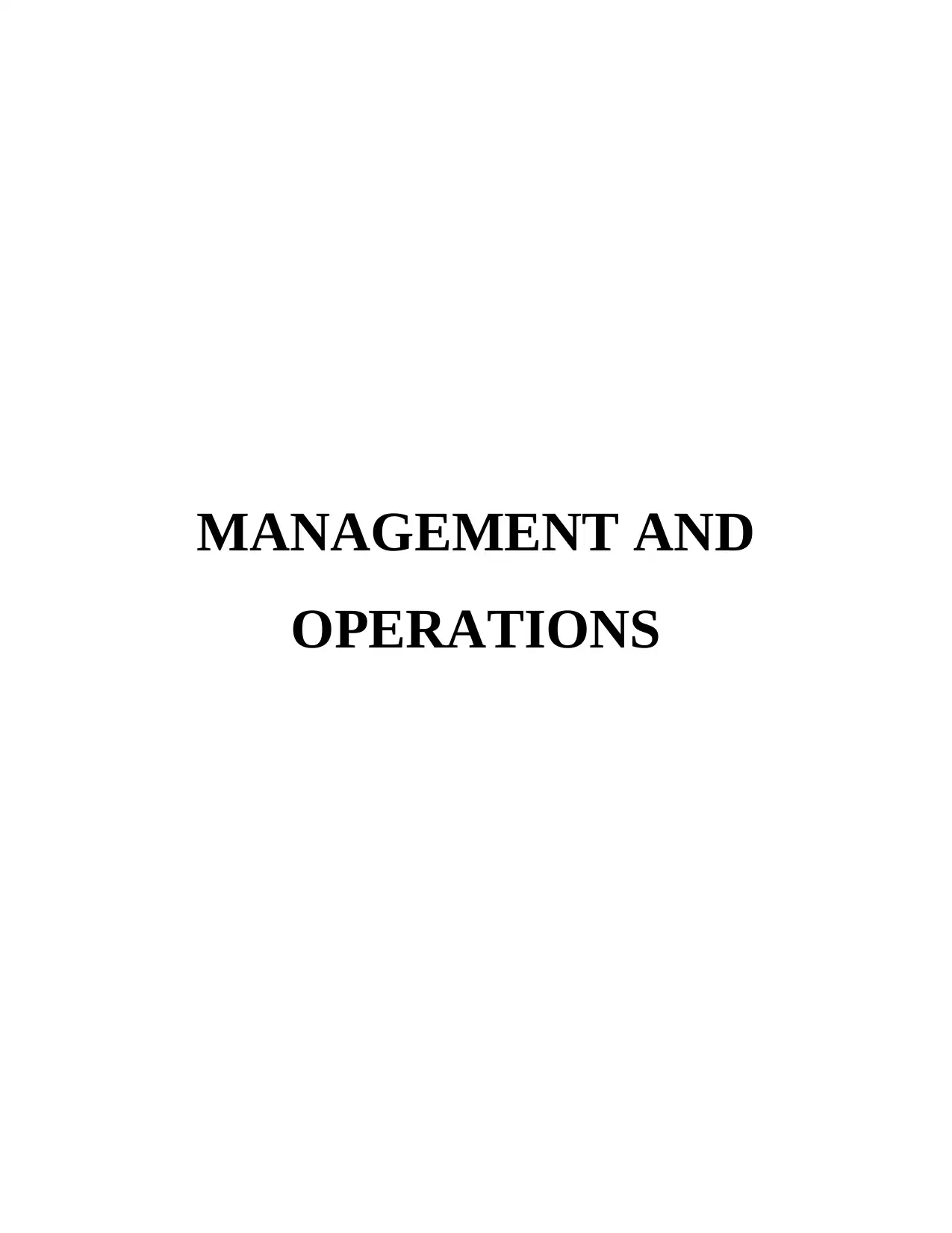
MANAGEMENT AND
OPERATIONS
OPERATIONS
Paraphrase This Document
Need a fresh take? Get an instant paraphrase of this document with our AI Paraphraser
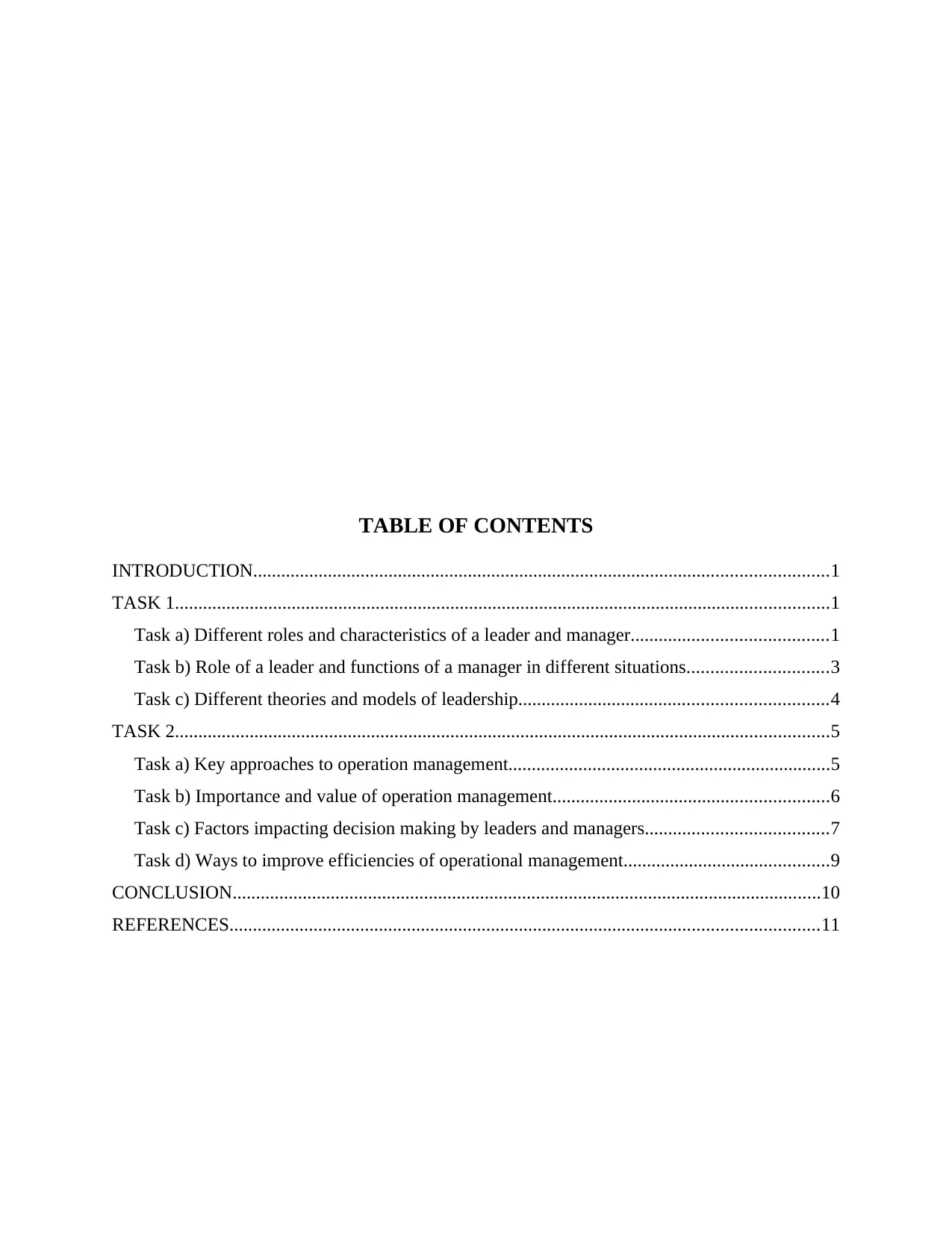
TABLE OF CONTENTS
INTRODUCTION...........................................................................................................................1
TASK 1............................................................................................................................................1
Task a) Different roles and characteristics of a leader and manager..........................................1
Task b) Role of a leader and functions of a manager in different situations..............................3
Task c) Different theories and models of leadership..................................................................4
TASK 2............................................................................................................................................5
Task a) Key approaches to operation management.....................................................................5
Task b) Importance and value of operation management...........................................................6
Task c) Factors impacting decision making by leaders and managers.......................................7
Task d) Ways to improve efficiencies of operational management............................................9
CONCLUSION..............................................................................................................................10
REFERENCES..............................................................................................................................11
INTRODUCTION...........................................................................................................................1
TASK 1............................................................................................................................................1
Task a) Different roles and characteristics of a leader and manager..........................................1
Task b) Role of a leader and functions of a manager in different situations..............................3
Task c) Different theories and models of leadership..................................................................4
TASK 2............................................................................................................................................5
Task a) Key approaches to operation management.....................................................................5
Task b) Importance and value of operation management...........................................................6
Task c) Factors impacting decision making by leaders and managers.......................................7
Task d) Ways to improve efficiencies of operational management............................................9
CONCLUSION..............................................................................................................................10
REFERENCES..............................................................................................................................11

⊘ This is a preview!⊘
Do you want full access?
Subscribe today to unlock all pages.

Trusted by 1+ million students worldwide
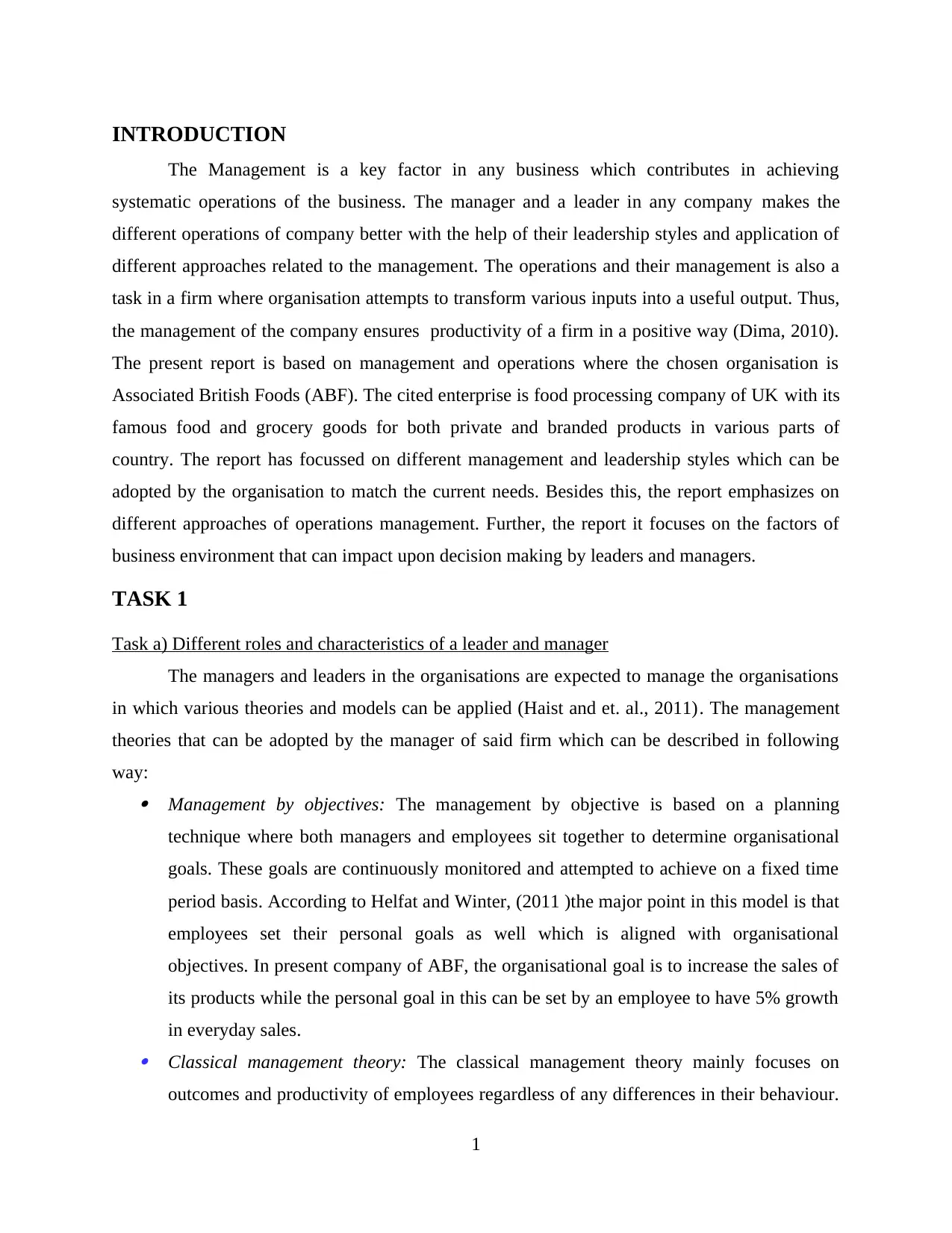
INTRODUCTION
The Management is a key factor in any business which contributes in achieving
systematic operations of the business. The manager and a leader in any company makes the
different operations of company better with the help of their leadership styles and application of
different approaches related to the management. The operations and their management is also a
task in a firm where organisation attempts to transform various inputs into a useful output. Thus,
the management of the company ensures productivity of a firm in a positive way (Dima, 2010).
The present report is based on management and operations where the chosen organisation is
Associated British Foods (ABF). The cited enterprise is food processing company of UK with its
famous food and grocery goods for both private and branded products in various parts of
country. The report has focussed on different management and leadership styles which can be
adopted by the organisation to match the current needs. Besides this, the report emphasizes on
different approaches of operations management. Further, the report it focuses on the factors of
business environment that can impact upon decision making by leaders and managers.
TASK 1
Task a) Different roles and characteristics of a leader and manager
The managers and leaders in the organisations are expected to manage the organisations
in which various theories and models can be applied (Haist and et. al., 2011). The management
theories that can be adopted by the manager of said firm which can be described in following
way: Management by objectives: The management by objective is based on a planning
technique where both managers and employees sit together to determine organisational
goals. These goals are continuously monitored and attempted to achieve on a fixed time
period basis. According to Helfat and Winter, (2011 )the major point in this model is that
employees set their personal goals as well which is aligned with organisational
objectives. In present company of ABF, the organisational goal is to increase the sales of
its products while the personal goal in this can be set by an employee to have 5% growth
in everyday sales. Classical management theory: The classical management theory mainly focuses on
outcomes and productivity of employees regardless of any differences in their behaviour.
1
The Management is a key factor in any business which contributes in achieving
systematic operations of the business. The manager and a leader in any company makes the
different operations of company better with the help of their leadership styles and application of
different approaches related to the management. The operations and their management is also a
task in a firm where organisation attempts to transform various inputs into a useful output. Thus,
the management of the company ensures productivity of a firm in a positive way (Dima, 2010).
The present report is based on management and operations where the chosen organisation is
Associated British Foods (ABF). The cited enterprise is food processing company of UK with its
famous food and grocery goods for both private and branded products in various parts of
country. The report has focussed on different management and leadership styles which can be
adopted by the organisation to match the current needs. Besides this, the report emphasizes on
different approaches of operations management. Further, the report it focuses on the factors of
business environment that can impact upon decision making by leaders and managers.
TASK 1
Task a) Different roles and characteristics of a leader and manager
The managers and leaders in the organisations are expected to manage the organisations
in which various theories and models can be applied (Haist and et. al., 2011). The management
theories that can be adopted by the manager of said firm which can be described in following
way: Management by objectives: The management by objective is based on a planning
technique where both managers and employees sit together to determine organisational
goals. These goals are continuously monitored and attempted to achieve on a fixed time
period basis. According to Helfat and Winter, (2011 )the major point in this model is that
employees set their personal goals as well which is aligned with organisational
objectives. In present company of ABF, the organisational goal is to increase the sales of
its products while the personal goal in this can be set by an employee to have 5% growth
in everyday sales. Classical management theory: The classical management theory mainly focuses on
outcomes and productivity of employees regardless of any differences in their behaviour.
1
Paraphrase This Document
Need a fresh take? Get an instant paraphrase of this document with our AI Paraphraser
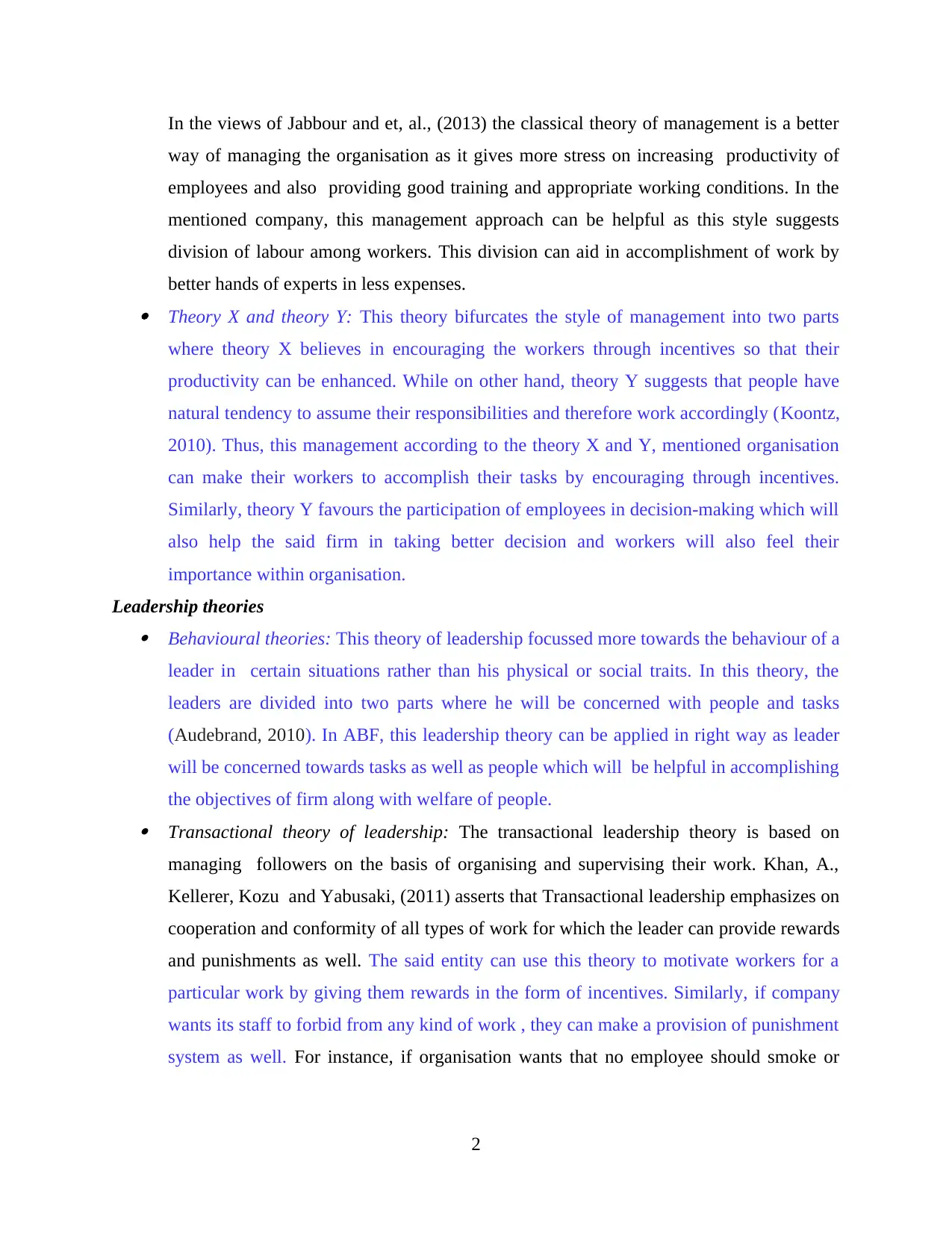
In the views of Jabbour and et, al., (2013) the classical theory of management is a better
way of managing the organisation as it gives more stress on increasing productivity of
employees and also providing good training and appropriate working conditions. In the
mentioned company, this management approach can be helpful as this style suggests
division of labour among workers. This division can aid in accomplishment of work by
better hands of experts in less expenses. Theory X and theory Y: This theory bifurcates the style of management into two parts
where theory X believes in encouraging the workers through incentives so that their
productivity can be enhanced. While on other hand, theory Y suggests that people have
natural tendency to assume their responsibilities and therefore work accordingly (Koontz,
2010). Thus, this management according to the theory X and Y, mentioned organisation
can make their workers to accomplish their tasks by encouraging through incentives.
Similarly, theory Y favours the participation of employees in decision-making which will
also help the said firm in taking better decision and workers will also feel their
importance within organisation.
Leadership theories Behavioural theories: This theory of leadership focussed more towards the behaviour of a
leader in certain situations rather than his physical or social traits. In this theory, the
leaders are divided into two parts where he will be concerned with people and tasks
(Audebrand, 2010). In ABF, this leadership theory can be applied in right way as leader
will be concerned towards tasks as well as people which will be helpful in accomplishing
the objectives of firm along with welfare of people. Transactional theory of leadership: The transactional leadership theory is based on
managing followers on the basis of organising and supervising their work. Khan, A.,
Kellerer, Kozu and Yabusaki, (2011) asserts that Transactional leadership emphasizes on
cooperation and conformity of all types of work for which the leader can provide rewards
and punishments as well. The said entity can use this theory to motivate workers for a
particular work by giving them rewards in the form of incentives. Similarly, if company
wants its staff to forbid from any kind of work , they can make a provision of punishment
system as well. For instance, if organisation wants that no employee should smoke or
2
way of managing the organisation as it gives more stress on increasing productivity of
employees and also providing good training and appropriate working conditions. In the
mentioned company, this management approach can be helpful as this style suggests
division of labour among workers. This division can aid in accomplishment of work by
better hands of experts in less expenses. Theory X and theory Y: This theory bifurcates the style of management into two parts
where theory X believes in encouraging the workers through incentives so that their
productivity can be enhanced. While on other hand, theory Y suggests that people have
natural tendency to assume their responsibilities and therefore work accordingly (Koontz,
2010). Thus, this management according to the theory X and Y, mentioned organisation
can make their workers to accomplish their tasks by encouraging through incentives.
Similarly, theory Y favours the participation of employees in decision-making which will
also help the said firm in taking better decision and workers will also feel their
importance within organisation.
Leadership theories Behavioural theories: This theory of leadership focussed more towards the behaviour of a
leader in certain situations rather than his physical or social traits. In this theory, the
leaders are divided into two parts where he will be concerned with people and tasks
(Audebrand, 2010). In ABF, this leadership theory can be applied in right way as leader
will be concerned towards tasks as well as people which will be helpful in accomplishing
the objectives of firm along with welfare of people. Transactional theory of leadership: The transactional leadership theory is based on
managing followers on the basis of organising and supervising their work. Khan, A.,
Kellerer, Kozu and Yabusaki, (2011) asserts that Transactional leadership emphasizes on
cooperation and conformity of all types of work for which the leader can provide rewards
and punishments as well. The said entity can use this theory to motivate workers for a
particular work by giving them rewards in the form of incentives. Similarly, if company
wants its staff to forbid from any kind of work , they can make a provision of punishment
system as well. For instance, if organisation wants that no employee should smoke or
2
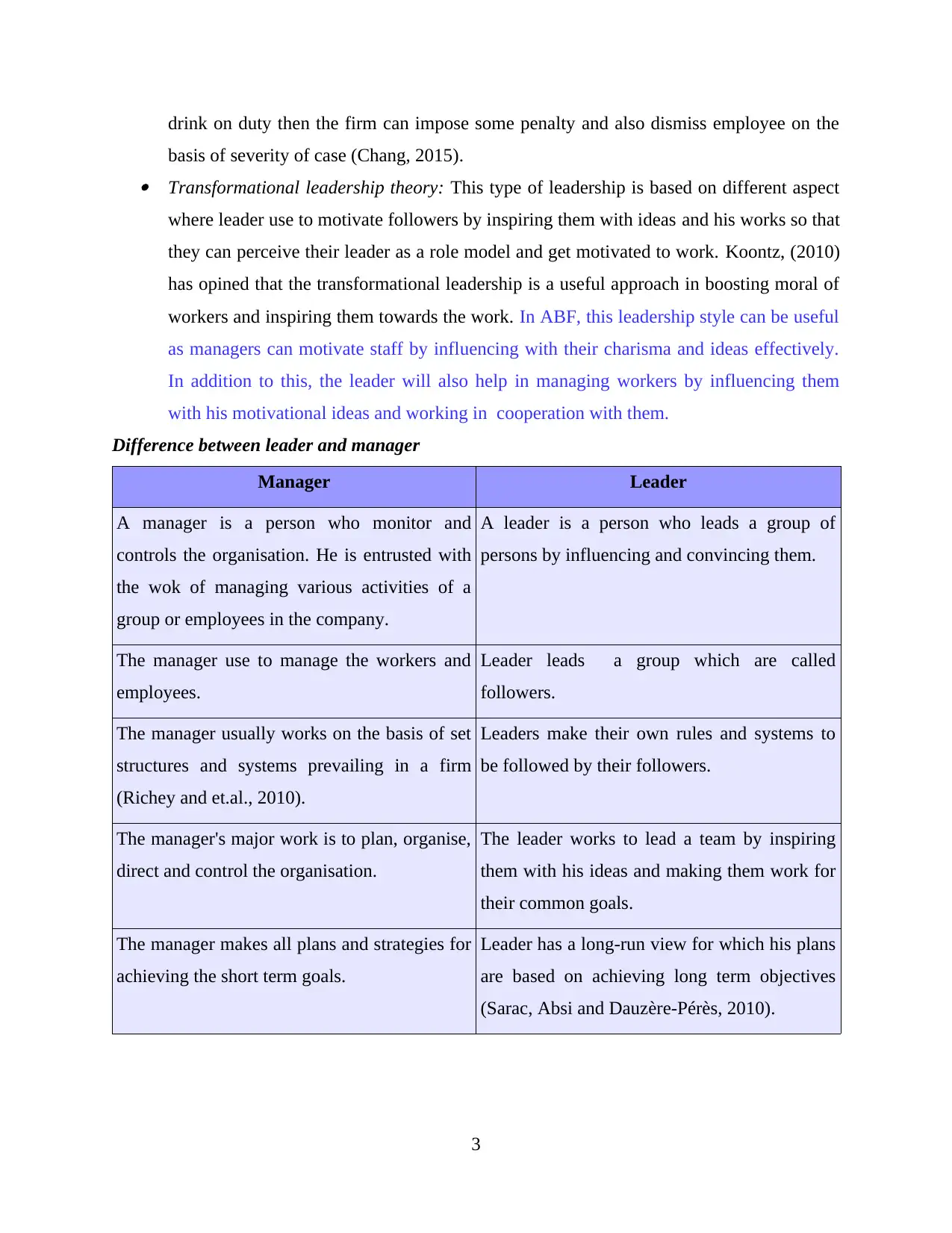
drink on duty then the firm can impose some penalty and also dismiss employee on the
basis of severity of case (Chang, 2015). Transformational leadership theory: This type of leadership is based on different aspect
where leader use to motivate followers by inspiring them with ideas and his works so that
they can perceive their leader as a role model and get motivated to work. Koontz, (2010)
has opined that the transformational leadership is a useful approach in boosting moral of
workers and inspiring them towards the work. In ABF, this leadership style can be useful
as managers can motivate staff by influencing with their charisma and ideas effectively.
In addition to this, the leader will also help in managing workers by influencing them
with his motivational ideas and working in cooperation with them.
Difference between leader and manager
Manager Leader
A manager is a person who monitor and
controls the organisation. He is entrusted with
the wok of managing various activities of a
group or employees in the company.
A leader is a person who leads a group of
persons by influencing and convincing them.
The manager use to manage the workers and
employees.
Leader leads a group which are called
followers.
The manager usually works on the basis of set
structures and systems prevailing in a firm
(Richey and et.al., 2010).
Leaders make their own rules and systems to
be followed by their followers.
The manager's major work is to plan, organise,
direct and control the organisation.
The leader works to lead a team by inspiring
them with his ideas and making them work for
their common goals.
The manager makes all plans and strategies for
achieving the short term goals.
Leader has a long-run view for which his plans
are based on achieving long term objectives
(Sarac, Absi and Dauzère-Pérès, 2010).
3
basis of severity of case (Chang, 2015). Transformational leadership theory: This type of leadership is based on different aspect
where leader use to motivate followers by inspiring them with ideas and his works so that
they can perceive their leader as a role model and get motivated to work. Koontz, (2010)
has opined that the transformational leadership is a useful approach in boosting moral of
workers and inspiring them towards the work. In ABF, this leadership style can be useful
as managers can motivate staff by influencing with their charisma and ideas effectively.
In addition to this, the leader will also help in managing workers by influencing them
with his motivational ideas and working in cooperation with them.
Difference between leader and manager
Manager Leader
A manager is a person who monitor and
controls the organisation. He is entrusted with
the wok of managing various activities of a
group or employees in the company.
A leader is a person who leads a group of
persons by influencing and convincing them.
The manager use to manage the workers and
employees.
Leader leads a group which are called
followers.
The manager usually works on the basis of set
structures and systems prevailing in a firm
(Richey and et.al., 2010).
Leaders make their own rules and systems to
be followed by their followers.
The manager's major work is to plan, organise,
direct and control the organisation.
The leader works to lead a team by inspiring
them with his ideas and making them work for
their common goals.
The manager makes all plans and strategies for
achieving the short term goals.
Leader has a long-run view for which his plans
are based on achieving long term objectives
(Sarac, Absi and Dauzère-Pérès, 2010).
3
⊘ This is a preview!⊘
Do you want full access?
Subscribe today to unlock all pages.

Trusted by 1+ million students worldwide
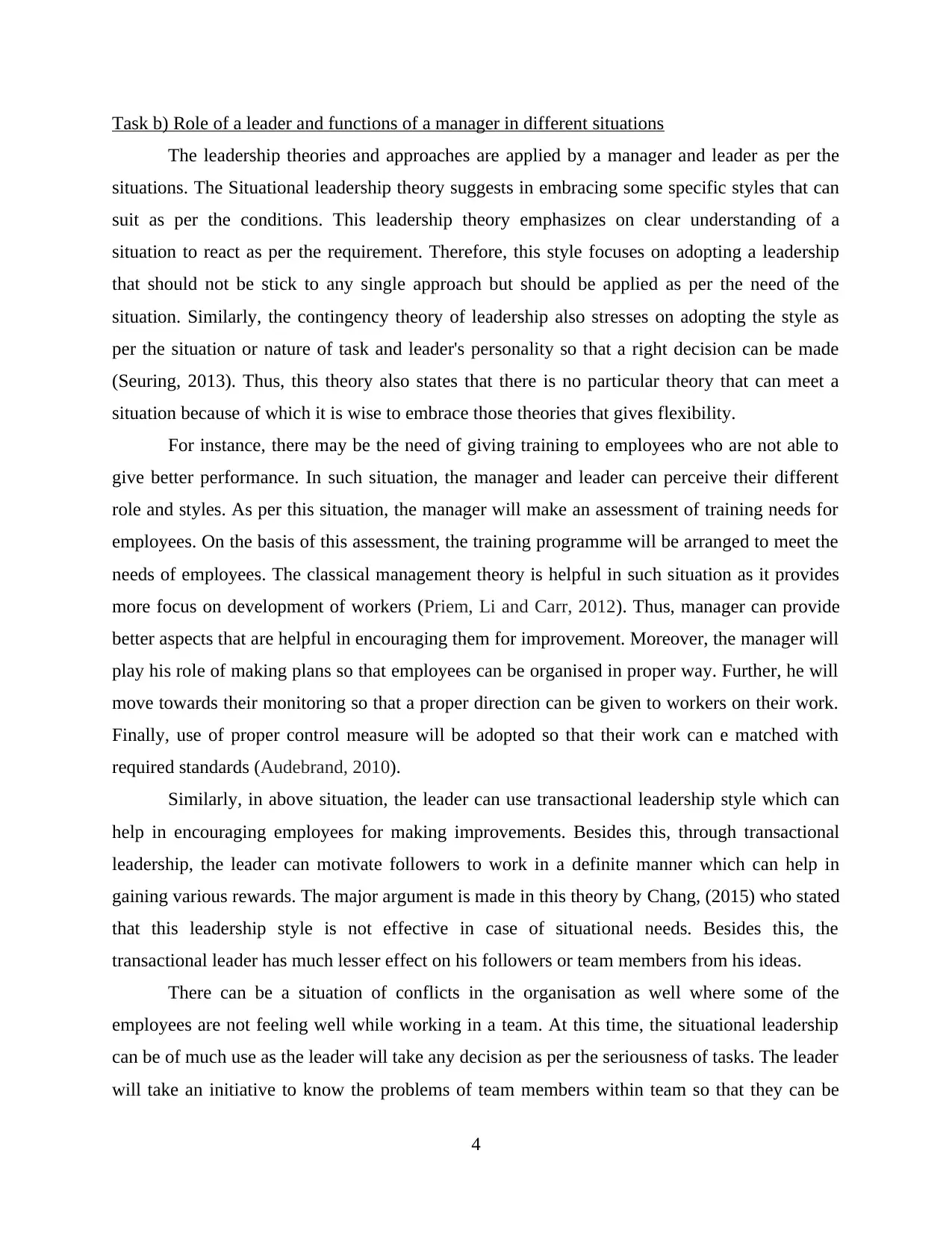
Task b) Role of a leader and functions of a manager in different situations
The leadership theories and approaches are applied by a manager and leader as per the
situations. The Situational leadership theory suggests in embracing some specific styles that can
suit as per the conditions. This leadership theory emphasizes on clear understanding of a
situation to react as per the requirement. Therefore, this style focuses on adopting a leadership
that should not be stick to any single approach but should be applied as per the need of the
situation. Similarly, the contingency theory of leadership also stresses on adopting the style as
per the situation or nature of task and leader's personality so that a right decision can be made
(Seuring, 2013). Thus, this theory also states that there is no particular theory that can meet a
situation because of which it is wise to embrace those theories that gives flexibility.
For instance, there may be the need of giving training to employees who are not able to
give better performance. In such situation, the manager and leader can perceive their different
role and styles. As per this situation, the manager will make an assessment of training needs for
employees. On the basis of this assessment, the training programme will be arranged to meet the
needs of employees. The classical management theory is helpful in such situation as it provides
more focus on development of workers (Priem, Li and Carr, 2012). Thus, manager can provide
better aspects that are helpful in encouraging them for improvement. Moreover, the manager will
play his role of making plans so that employees can be organised in proper way. Further, he will
move towards their monitoring so that a proper direction can be given to workers on their work.
Finally, use of proper control measure will be adopted so that their work can e matched with
required standards (Audebrand, 2010).
Similarly, in above situation, the leader can use transactional leadership style which can
help in encouraging employees for making improvements. Besides this, through transactional
leadership, the leader can motivate followers to work in a definite manner which can help in
gaining various rewards. The major argument is made in this theory by Chang, (2015) who stated
that this leadership style is not effective in case of situational needs. Besides this, the
transactional leader has much lesser effect on his followers or team members from his ideas.
There can be a situation of conflicts in the organisation as well where some of the
employees are not feeling well while working in a team. At this time, the situational leadership
can be of much use as the leader will take any decision as per the seriousness of tasks. The leader
will take an initiative to know the problems of team members within team so that they can be
4
The leadership theories and approaches are applied by a manager and leader as per the
situations. The Situational leadership theory suggests in embracing some specific styles that can
suit as per the conditions. This leadership theory emphasizes on clear understanding of a
situation to react as per the requirement. Therefore, this style focuses on adopting a leadership
that should not be stick to any single approach but should be applied as per the need of the
situation. Similarly, the contingency theory of leadership also stresses on adopting the style as
per the situation or nature of task and leader's personality so that a right decision can be made
(Seuring, 2013). Thus, this theory also states that there is no particular theory that can meet a
situation because of which it is wise to embrace those theories that gives flexibility.
For instance, there may be the need of giving training to employees who are not able to
give better performance. In such situation, the manager and leader can perceive their different
role and styles. As per this situation, the manager will make an assessment of training needs for
employees. On the basis of this assessment, the training programme will be arranged to meet the
needs of employees. The classical management theory is helpful in such situation as it provides
more focus on development of workers (Priem, Li and Carr, 2012). Thus, manager can provide
better aspects that are helpful in encouraging them for improvement. Moreover, the manager will
play his role of making plans so that employees can be organised in proper way. Further, he will
move towards their monitoring so that a proper direction can be given to workers on their work.
Finally, use of proper control measure will be adopted so that their work can e matched with
required standards (Audebrand, 2010).
Similarly, in above situation, the leader can use transactional leadership style which can
help in encouraging employees for making improvements. Besides this, through transactional
leadership, the leader can motivate followers to work in a definite manner which can help in
gaining various rewards. The major argument is made in this theory by Chang, (2015) who stated
that this leadership style is not effective in case of situational needs. Besides this, the
transactional leader has much lesser effect on his followers or team members from his ideas.
There can be a situation of conflicts in the organisation as well where some of the
employees are not feeling well while working in a team. At this time, the situational leadership
can be of much use as the leader will take any decision as per the seriousness of tasks. The leader
will take an initiative to know the problems of team members within team so that they can be
4
Paraphrase This Document
Need a fresh take? Get an instant paraphrase of this document with our AI Paraphraser
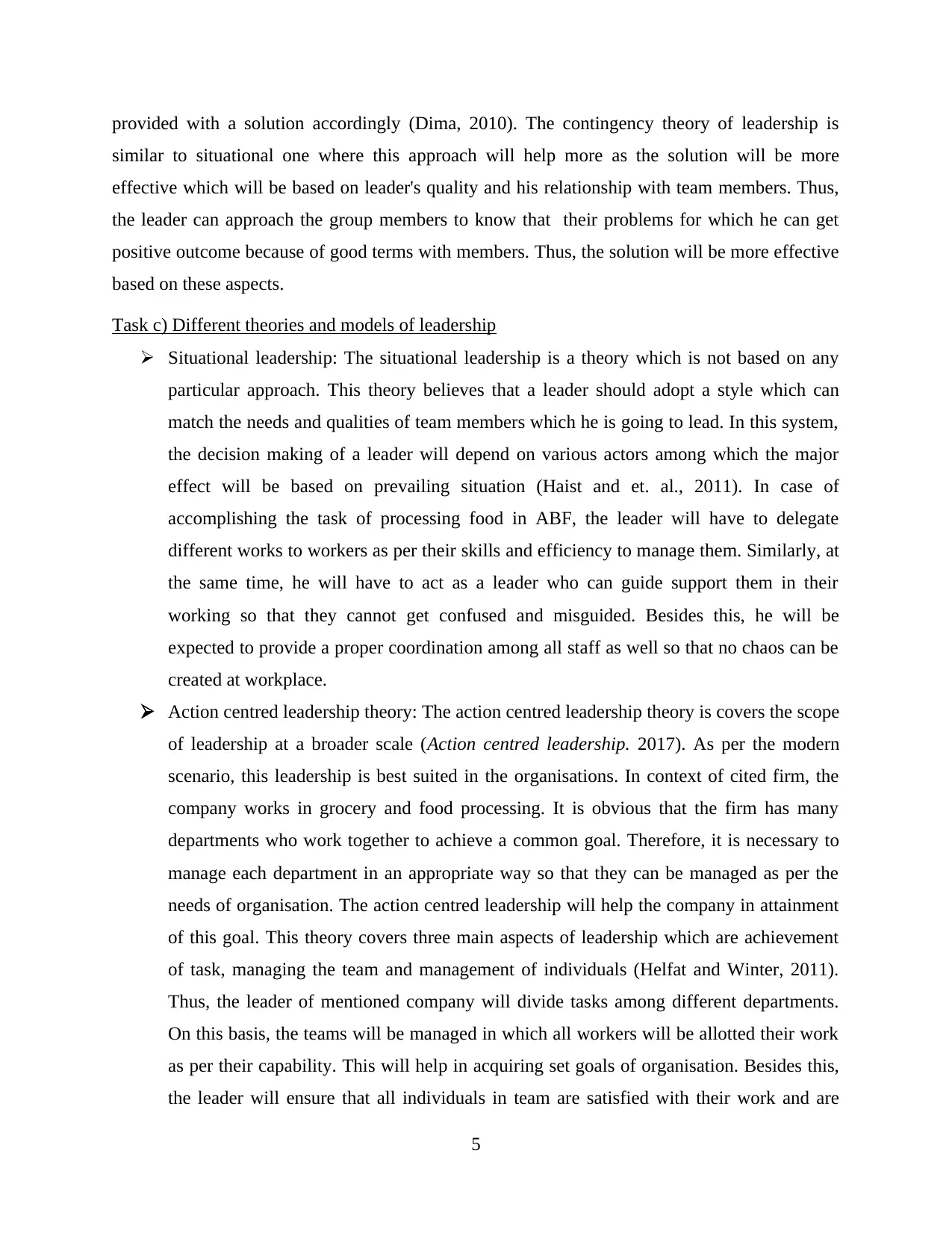
provided with a solution accordingly (Dima, 2010). The contingency theory of leadership is
similar to situational one where this approach will help more as the solution will be more
effective which will be based on leader's quality and his relationship with team members. Thus,
the leader can approach the group members to know that their problems for which he can get
positive outcome because of good terms with members. Thus, the solution will be more effective
based on these aspects.
Task c) Different theories and models of leadership
Situational leadership: The situational leadership is a theory which is not based on any
particular approach. This theory believes that a leader should adopt a style which can
match the needs and qualities of team members which he is going to lead. In this system,
the decision making of a leader will depend on various actors among which the major
effect will be based on prevailing situation (Haist and et. al., 2011). In case of
accomplishing the task of processing food in ABF, the leader will have to delegate
different works to workers as per their skills and efficiency to manage them. Similarly, at
the same time, he will have to act as a leader who can guide support them in their
working so that they cannot get confused and misguided. Besides this, he will be
expected to provide a proper coordination among all staff as well so that no chaos can be
created at workplace.
Action centred leadership theory: The action centred leadership theory is covers the scope
of leadership at a broader scale (Action centred leadership. 2017). As per the modern
scenario, this leadership is best suited in the organisations. In context of cited firm, the
company works in grocery and food processing. It is obvious that the firm has many
departments who work together to achieve a common goal. Therefore, it is necessary to
manage each department in an appropriate way so that they can be managed as per the
needs of organisation. The action centred leadership will help the company in attainment
of this goal. This theory covers three main aspects of leadership which are achievement
of task, managing the team and management of individuals (Helfat and Winter, 2011).
Thus, the leader of mentioned company will divide tasks among different departments.
On this basis, the teams will be managed in which all workers will be allotted their work
as per their capability. This will help in acquiring set goals of organisation. Besides this,
the leader will ensure that all individuals in team are satisfied with their work and are
5
similar to situational one where this approach will help more as the solution will be more
effective which will be based on leader's quality and his relationship with team members. Thus,
the leader can approach the group members to know that their problems for which he can get
positive outcome because of good terms with members. Thus, the solution will be more effective
based on these aspects.
Task c) Different theories and models of leadership
Situational leadership: The situational leadership is a theory which is not based on any
particular approach. This theory believes that a leader should adopt a style which can
match the needs and qualities of team members which he is going to lead. In this system,
the decision making of a leader will depend on various actors among which the major
effect will be based on prevailing situation (Haist and et. al., 2011). In case of
accomplishing the task of processing food in ABF, the leader will have to delegate
different works to workers as per their skills and efficiency to manage them. Similarly, at
the same time, he will have to act as a leader who can guide support them in their
working so that they cannot get confused and misguided. Besides this, he will be
expected to provide a proper coordination among all staff as well so that no chaos can be
created at workplace.
Action centred leadership theory: The action centred leadership theory is covers the scope
of leadership at a broader scale (Action centred leadership. 2017). As per the modern
scenario, this leadership is best suited in the organisations. In context of cited firm, the
company works in grocery and food processing. It is obvious that the firm has many
departments who work together to achieve a common goal. Therefore, it is necessary to
manage each department in an appropriate way so that they can be managed as per the
needs of organisation. The action centred leadership will help the company in attainment
of this goal. This theory covers three main aspects of leadership which are achievement
of task, managing the team and management of individuals (Helfat and Winter, 2011).
Thus, the leader of mentioned company will divide tasks among different departments.
On this basis, the teams will be managed in which all workers will be allotted their work
as per their capability. This will help in acquiring set goals of organisation. Besides this,
the leader will ensure that all individuals in team are satisfied with their work and are
5
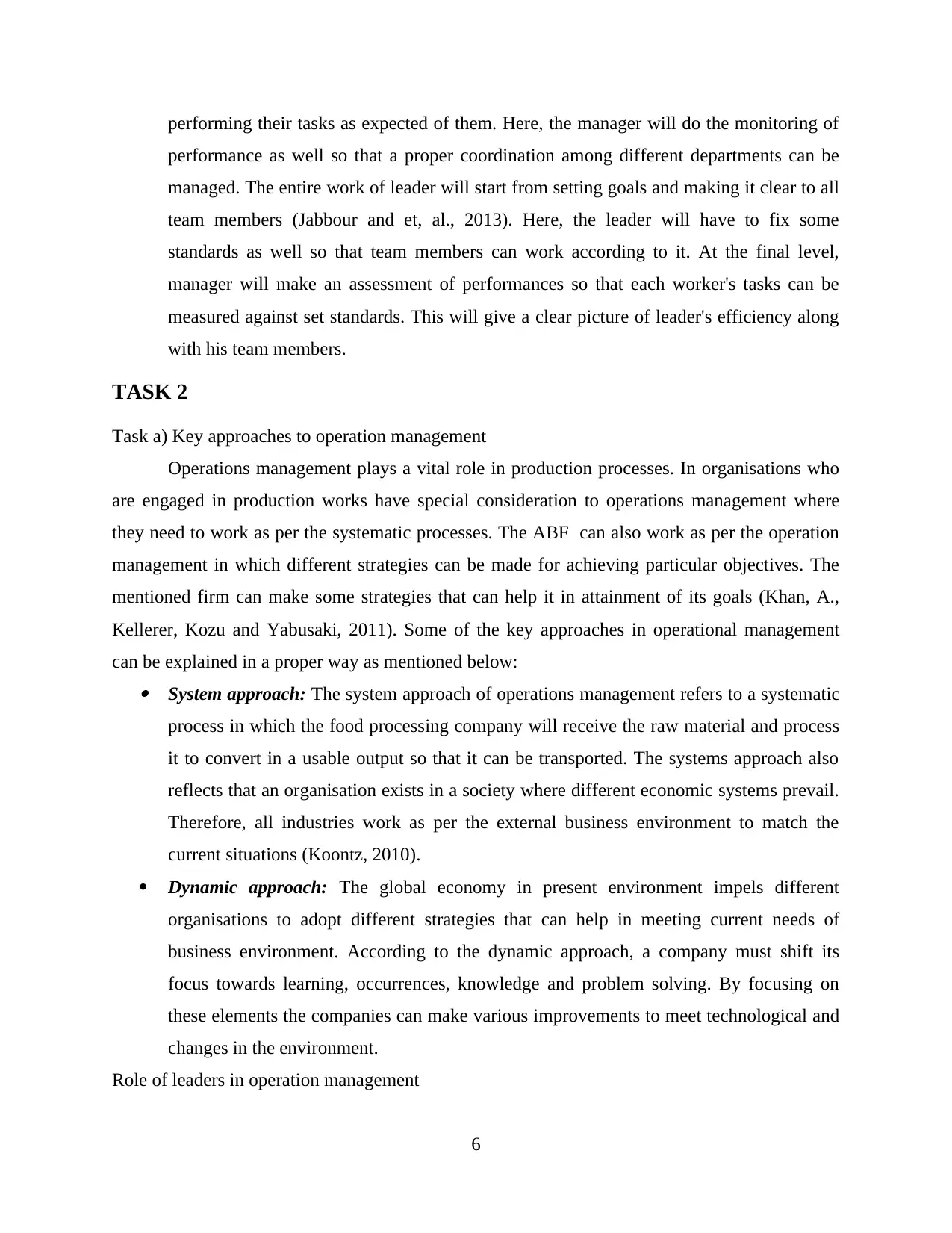
performing their tasks as expected of them. Here, the manager will do the monitoring of
performance as well so that a proper coordination among different departments can be
managed. The entire work of leader will start from setting goals and making it clear to all
team members (Jabbour and et, al., 2013). Here, the leader will have to fix some
standards as well so that team members can work according to it. At the final level,
manager will make an assessment of performances so that each worker's tasks can be
measured against set standards. This will give a clear picture of leader's efficiency along
with his team members.
TASK 2
Task a) Key approaches to operation management
Operations management plays a vital role in production processes. In organisations who
are engaged in production works have special consideration to operations management where
they need to work as per the systematic processes. The ABF can also work as per the operation
management in which different strategies can be made for achieving particular objectives. The
mentioned firm can make some strategies that can help it in attainment of its goals (Khan, A.,
Kellerer, Kozu and Yabusaki, 2011). Some of the key approaches in operational management
can be explained in a proper way as mentioned below: System approach: The system approach of operations management refers to a systematic
process in which the food processing company will receive the raw material and process
it to convert in a usable output so that it can be transported. The systems approach also
reflects that an organisation exists in a society where different economic systems prevail.
Therefore, all industries work as per the external business environment to match the
current situations (Koontz, 2010).
Dynamic approach: The global economy in present environment impels different
organisations to adopt different strategies that can help in meeting current needs of
business environment. According to the dynamic approach, a company must shift its
focus towards learning, occurrences, knowledge and problem solving. By focusing on
these elements the companies can make various improvements to meet technological and
changes in the environment.
Role of leaders in operation management
6
performance as well so that a proper coordination among different departments can be
managed. The entire work of leader will start from setting goals and making it clear to all
team members (Jabbour and et, al., 2013). Here, the leader will have to fix some
standards as well so that team members can work according to it. At the final level,
manager will make an assessment of performances so that each worker's tasks can be
measured against set standards. This will give a clear picture of leader's efficiency along
with his team members.
TASK 2
Task a) Key approaches to operation management
Operations management plays a vital role in production processes. In organisations who
are engaged in production works have special consideration to operations management where
they need to work as per the systematic processes. The ABF can also work as per the operation
management in which different strategies can be made for achieving particular objectives. The
mentioned firm can make some strategies that can help it in attainment of its goals (Khan, A.,
Kellerer, Kozu and Yabusaki, 2011). Some of the key approaches in operational management
can be explained in a proper way as mentioned below: System approach: The system approach of operations management refers to a systematic
process in which the food processing company will receive the raw material and process
it to convert in a usable output so that it can be transported. The systems approach also
reflects that an organisation exists in a society where different economic systems prevail.
Therefore, all industries work as per the external business environment to match the
current situations (Koontz, 2010).
Dynamic approach: The global economy in present environment impels different
organisations to adopt different strategies that can help in meeting current needs of
business environment. According to the dynamic approach, a company must shift its
focus towards learning, occurrences, knowledge and problem solving. By focusing on
these elements the companies can make various improvements to meet technological and
changes in the environment.
Role of leaders in operation management
6
⊘ This is a preview!⊘
Do you want full access?
Subscribe today to unlock all pages.

Trusted by 1+ million students worldwide
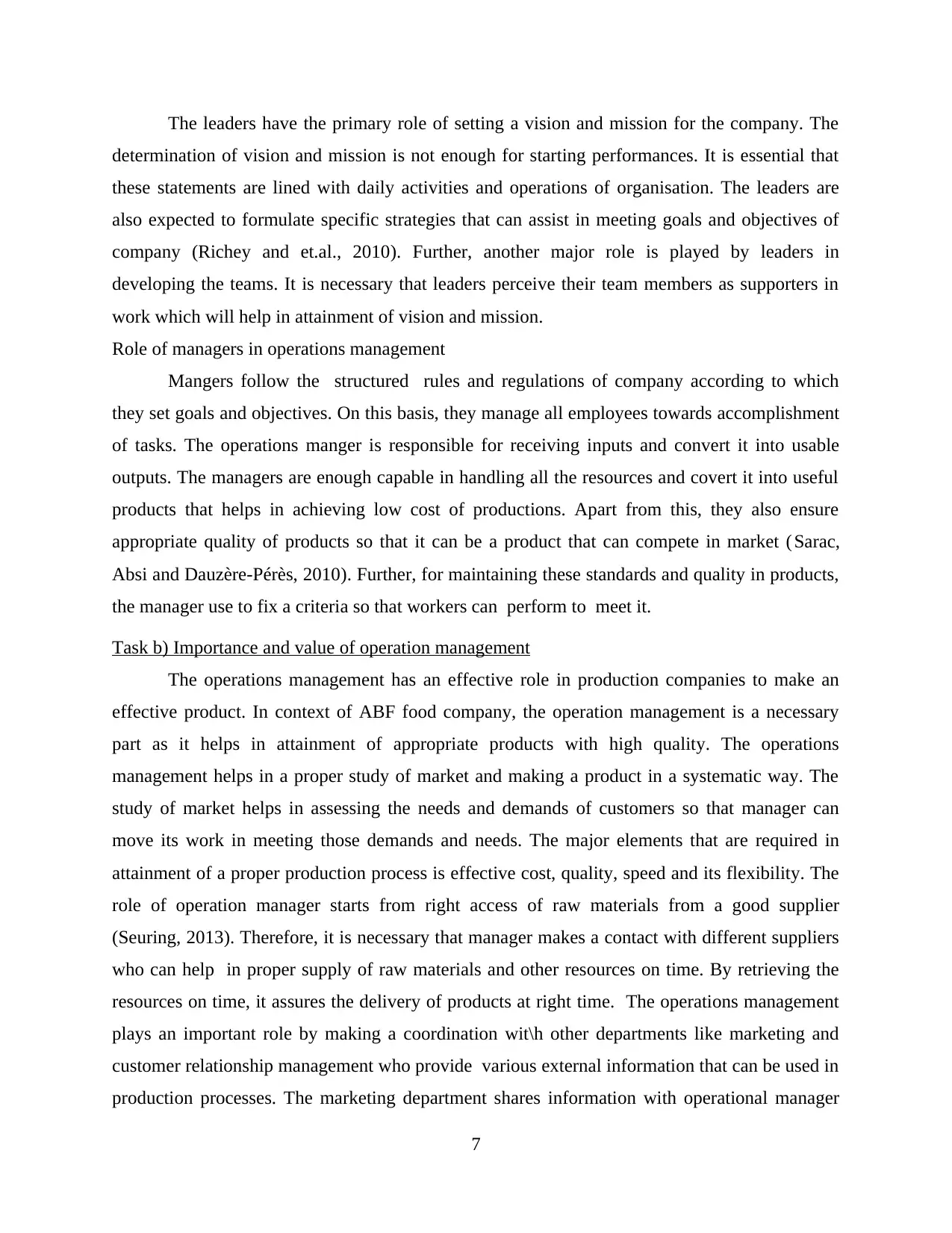
The leaders have the primary role of setting a vision and mission for the company. The
determination of vision and mission is not enough for starting performances. It is essential that
these statements are lined with daily activities and operations of organisation. The leaders are
also expected to formulate specific strategies that can assist in meeting goals and objectives of
company (Richey and et.al., 2010). Further, another major role is played by leaders in
developing the teams. It is necessary that leaders perceive their team members as supporters in
work which will help in attainment of vision and mission.
Role of managers in operations management
Mangers follow the structured rules and regulations of company according to which
they set goals and objectives. On this basis, they manage all employees towards accomplishment
of tasks. The operations manger is responsible for receiving inputs and convert it into usable
outputs. The managers are enough capable in handling all the resources and covert it into useful
products that helps in achieving low cost of productions. Apart from this, they also ensure
appropriate quality of products so that it can be a product that can compete in market ( Sarac,
Absi and Dauzère-Pérès, 2010). Further, for maintaining these standards and quality in products,
the manager use to fix a criteria so that workers can perform to meet it.
Task b) Importance and value of operation management
The operations management has an effective role in production companies to make an
effective product. In context of ABF food company, the operation management is a necessary
part as it helps in attainment of appropriate products with high quality. The operations
management helps in a proper study of market and making a product in a systematic way. The
study of market helps in assessing the needs and demands of customers so that manager can
move its work in meeting those demands and needs. The major elements that are required in
attainment of a proper production process is effective cost, quality, speed and its flexibility. The
role of operation manager starts from right access of raw materials from a good supplier
(Seuring, 2013). Therefore, it is necessary that manager makes a contact with different suppliers
who can help in proper supply of raw materials and other resources on time. By retrieving the
resources on time, it assures the delivery of products at right time. The operations management
plays an important role by making a coordination wit\h other departments like marketing and
customer relationship management who provide various external information that can be used in
production processes. The marketing department shares information with operational manager
7
determination of vision and mission is not enough for starting performances. It is essential that
these statements are lined with daily activities and operations of organisation. The leaders are
also expected to formulate specific strategies that can assist in meeting goals and objectives of
company (Richey and et.al., 2010). Further, another major role is played by leaders in
developing the teams. It is necessary that leaders perceive their team members as supporters in
work which will help in attainment of vision and mission.
Role of managers in operations management
Mangers follow the structured rules and regulations of company according to which
they set goals and objectives. On this basis, they manage all employees towards accomplishment
of tasks. The operations manger is responsible for receiving inputs and convert it into usable
outputs. The managers are enough capable in handling all the resources and covert it into useful
products that helps in achieving low cost of productions. Apart from this, they also ensure
appropriate quality of products so that it can be a product that can compete in market ( Sarac,
Absi and Dauzère-Pérès, 2010). Further, for maintaining these standards and quality in products,
the manager use to fix a criteria so that workers can perform to meet it.
Task b) Importance and value of operation management
The operations management has an effective role in production companies to make an
effective product. In context of ABF food company, the operation management is a necessary
part as it helps in attainment of appropriate products with high quality. The operations
management helps in a proper study of market and making a product in a systematic way. The
study of market helps in assessing the needs and demands of customers so that manager can
move its work in meeting those demands and needs. The major elements that are required in
attainment of a proper production process is effective cost, quality, speed and its flexibility. The
role of operation manager starts from right access of raw materials from a good supplier
(Seuring, 2013). Therefore, it is necessary that manager makes a contact with different suppliers
who can help in proper supply of raw materials and other resources on time. By retrieving the
resources on time, it assures the delivery of products at right time. The operations management
plays an important role by making a coordination wit\h other departments like marketing and
customer relationship management who provide various external information that can be used in
production processes. The marketing department shares information with operational manager
7
Paraphrase This Document
Need a fresh take? Get an instant paraphrase of this document with our AI Paraphraser
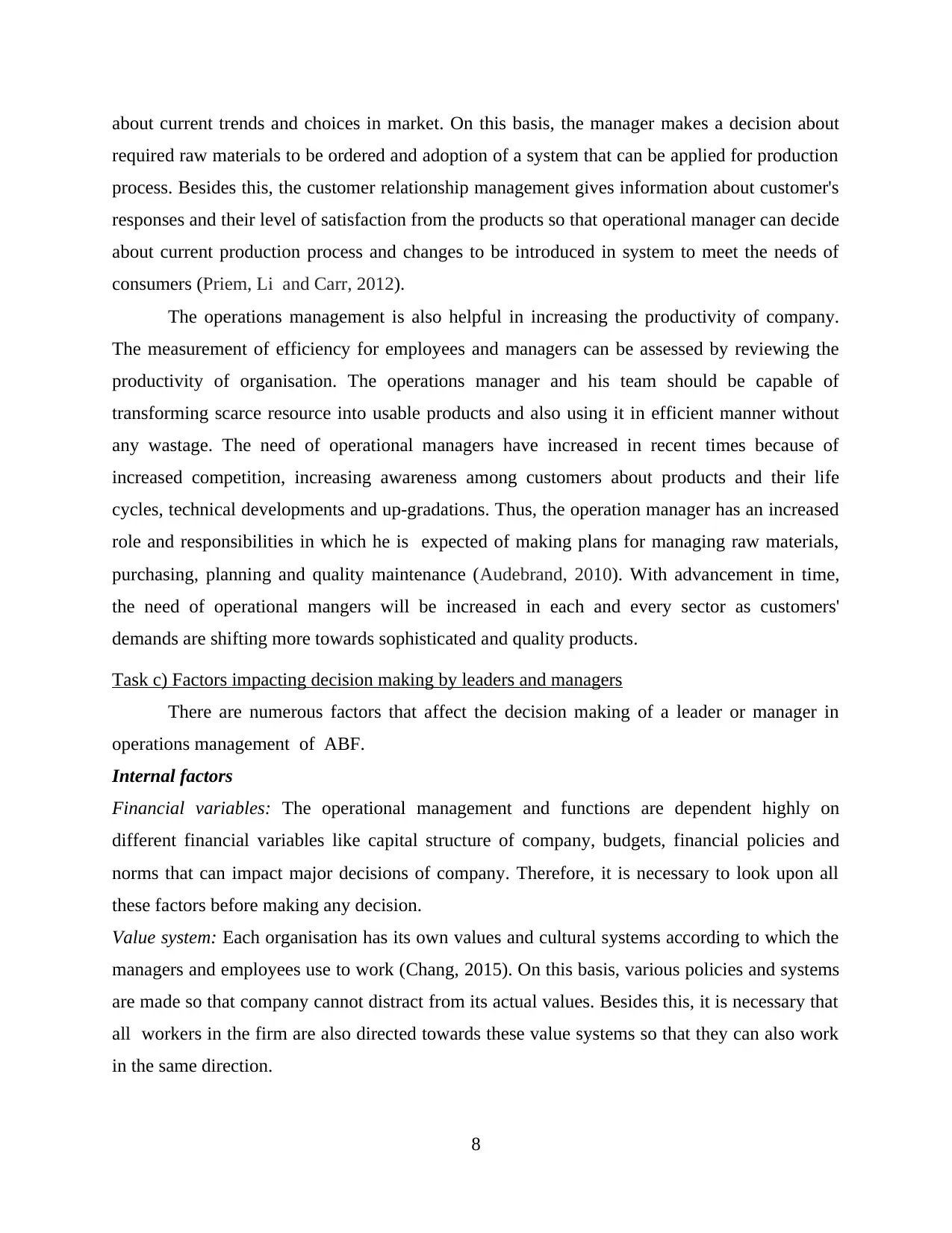
about current trends and choices in market. On this basis, the manager makes a decision about
required raw materials to be ordered and adoption of a system that can be applied for production
process. Besides this, the customer relationship management gives information about customer's
responses and their level of satisfaction from the products so that operational manager can decide
about current production process and changes to be introduced in system to meet the needs of
consumers (Priem, Li and Carr, 2012).
The operations management is also helpful in increasing the productivity of company.
The measurement of efficiency for employees and managers can be assessed by reviewing the
productivity of organisation. The operations manager and his team should be capable of
transforming scarce resource into usable products and also using it in efficient manner without
any wastage. The need of operational managers have increased in recent times because of
increased competition, increasing awareness among customers about products and their life
cycles, technical developments and up-gradations. Thus, the operation manager has an increased
role and responsibilities in which he is expected of making plans for managing raw materials,
purchasing, planning and quality maintenance (Audebrand, 2010). With advancement in time,
the need of operational mangers will be increased in each and every sector as customers'
demands are shifting more towards sophisticated and quality products.
Task c) Factors impacting decision making by leaders and managers
There are numerous factors that affect the decision making of a leader or manager in
operations management of ABF.
Internal factors
Financial variables: The operational management and functions are dependent highly on
different financial variables like capital structure of company, budgets, financial policies and
norms that can impact major decisions of company. Therefore, it is necessary to look upon all
these factors before making any decision.
Value system: Each organisation has its own values and cultural systems according to which the
managers and employees use to work (Chang, 2015). On this basis, various policies and systems
are made so that company cannot distract from its actual values. Besides this, it is necessary that
all workers in the firm are also directed towards these value systems so that they can also work
in the same direction.
8
required raw materials to be ordered and adoption of a system that can be applied for production
process. Besides this, the customer relationship management gives information about customer's
responses and their level of satisfaction from the products so that operational manager can decide
about current production process and changes to be introduced in system to meet the needs of
consumers (Priem, Li and Carr, 2012).
The operations management is also helpful in increasing the productivity of company.
The measurement of efficiency for employees and managers can be assessed by reviewing the
productivity of organisation. The operations manager and his team should be capable of
transforming scarce resource into usable products and also using it in efficient manner without
any wastage. The need of operational managers have increased in recent times because of
increased competition, increasing awareness among customers about products and their life
cycles, technical developments and up-gradations. Thus, the operation manager has an increased
role and responsibilities in which he is expected of making plans for managing raw materials,
purchasing, planning and quality maintenance (Audebrand, 2010). With advancement in time,
the need of operational mangers will be increased in each and every sector as customers'
demands are shifting more towards sophisticated and quality products.
Task c) Factors impacting decision making by leaders and managers
There are numerous factors that affect the decision making of a leader or manager in
operations management of ABF.
Internal factors
Financial variables: The operational management and functions are dependent highly on
different financial variables like capital structure of company, budgets, financial policies and
norms that can impact major decisions of company. Therefore, it is necessary to look upon all
these factors before making any decision.
Value system: Each organisation has its own values and cultural systems according to which the
managers and employees use to work (Chang, 2015). On this basis, various policies and systems
are made so that company cannot distract from its actual values. Besides this, it is necessary that
all workers in the firm are also directed towards these value systems so that they can also work
in the same direction.
8
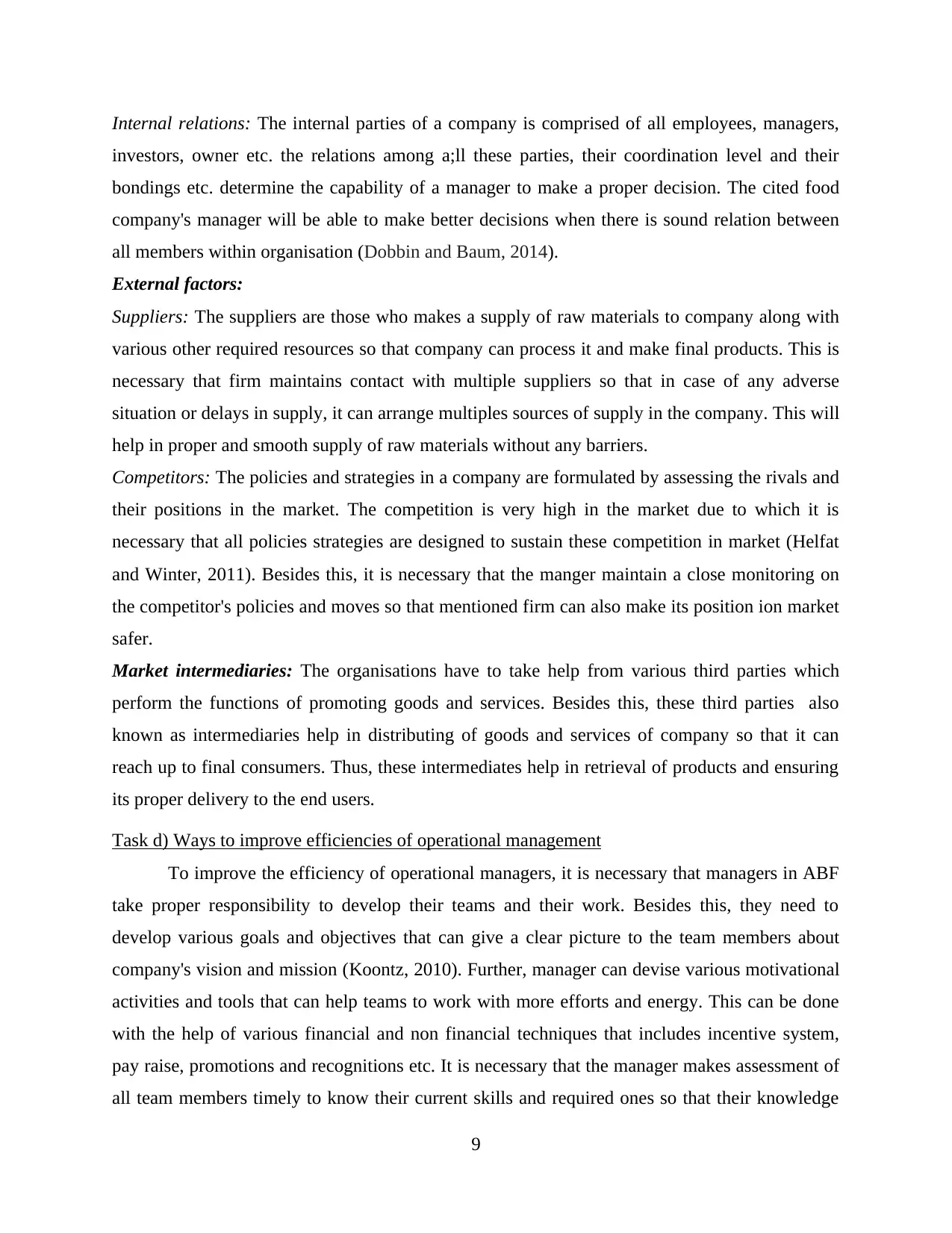
Internal relations: The internal parties of a company is comprised of all employees, managers,
investors, owner etc. the relations among a;ll these parties, their coordination level and their
bondings etc. determine the capability of a manager to make a proper decision. The cited food
company's manager will be able to make better decisions when there is sound relation between
all members within organisation (Dobbin and Baum, 2014).
External factors:
Suppliers: The suppliers are those who makes a supply of raw materials to company along with
various other required resources so that company can process it and make final products. This is
necessary that firm maintains contact with multiple suppliers so that in case of any adverse
situation or delays in supply, it can arrange multiples sources of supply in the company. This will
help in proper and smooth supply of raw materials without any barriers.
Competitors: The policies and strategies in a company are formulated by assessing the rivals and
their positions in the market. The competition is very high in the market due to which it is
necessary that all policies strategies are designed to sustain these competition in market (Helfat
and Winter, 2011). Besides this, it is necessary that the manger maintain a close monitoring on
the competitor's policies and moves so that mentioned firm can also make its position ion market
safer.
Market intermediaries: The organisations have to take help from various third parties which
perform the functions of promoting goods and services. Besides this, these third parties also
known as intermediaries help in distributing of goods and services of company so that it can
reach up to final consumers. Thus, these intermediates help in retrieval of products and ensuring
its proper delivery to the end users.
Task d) Ways to improve efficiencies of operational management
To improve the efficiency of operational managers, it is necessary that managers in ABF
take proper responsibility to develop their teams and their work. Besides this, they need to
develop various goals and objectives that can give a clear picture to the team members about
company's vision and mission (Koontz, 2010). Further, manager can devise various motivational
activities and tools that can help teams to work with more efforts and energy. This can be done
with the help of various financial and non financial techniques that includes incentive system,
pay raise, promotions and recognitions etc. It is necessary that the manager makes assessment of
all team members timely to know their current skills and required ones so that their knowledge
9
investors, owner etc. the relations among a;ll these parties, their coordination level and their
bondings etc. determine the capability of a manager to make a proper decision. The cited food
company's manager will be able to make better decisions when there is sound relation between
all members within organisation (Dobbin and Baum, 2014).
External factors:
Suppliers: The suppliers are those who makes a supply of raw materials to company along with
various other required resources so that company can process it and make final products. This is
necessary that firm maintains contact with multiple suppliers so that in case of any adverse
situation or delays in supply, it can arrange multiples sources of supply in the company. This will
help in proper and smooth supply of raw materials without any barriers.
Competitors: The policies and strategies in a company are formulated by assessing the rivals and
their positions in the market. The competition is very high in the market due to which it is
necessary that all policies strategies are designed to sustain these competition in market (Helfat
and Winter, 2011). Besides this, it is necessary that the manger maintain a close monitoring on
the competitor's policies and moves so that mentioned firm can also make its position ion market
safer.
Market intermediaries: The organisations have to take help from various third parties which
perform the functions of promoting goods and services. Besides this, these third parties also
known as intermediaries help in distributing of goods and services of company so that it can
reach up to final consumers. Thus, these intermediates help in retrieval of products and ensuring
its proper delivery to the end users.
Task d) Ways to improve efficiencies of operational management
To improve the efficiency of operational managers, it is necessary that managers in ABF
take proper responsibility to develop their teams and their work. Besides this, they need to
develop various goals and objectives that can give a clear picture to the team members about
company's vision and mission (Koontz, 2010). Further, manager can devise various motivational
activities and tools that can help teams to work with more efforts and energy. This can be done
with the help of various financial and non financial techniques that includes incentive system,
pay raise, promotions and recognitions etc. It is necessary that the manager makes assessment of
all team members timely to know their current skills and required ones so that their knowledge
9
⊘ This is a preview!⊘
Do you want full access?
Subscribe today to unlock all pages.

Trusted by 1+ million students worldwide
1 out of 17
Related Documents
Your All-in-One AI-Powered Toolkit for Academic Success.
+13062052269
info@desklib.com
Available 24*7 on WhatsApp / Email
![[object Object]](/_next/static/media/star-bottom.7253800d.svg)
Unlock your academic potential
Copyright © 2020–2025 A2Z Services. All Rights Reserved. Developed and managed by ZUCOL.




